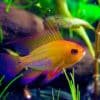-
×
-
×
-
×
-
×
-
×
-
×
Subtotal: £131.45



















Emily Carter (verified owner) –
I recently added a pair of Apistogramma Agassizii «Double Red» to my 30-gallon aquarium, and I couldn’t be happier with my decision! After about two weeks, I’ve noticed their vibrant colors just pop in the tank, especially when they swim among the plants. The male displays a stunning red hue, while the female has beautiful, delicate patterns that are mesmerizing to watch.
These dwarf cichlids have brought such personality to my setup! They explore their environment actively, and I’ve observed some delightful behaviors, like the male defending their territory and the female nurturing any eggs laid. I appreciate how they have adapted well despite the initial stress of transport.
Compared to other dwarf cichlids I’ve kept, like the Rams, these Agassizii are more engaging and less skittish, making them perfect for an aquarist looking for lively aquarium fish. Just be cautious with tank mates, as they can be territorial during breeding.
Shipping was quick, and both fish arrived healthy and vibrant. I highly recommend this pair for any aquarist who values both beauty and character in their tropical fish!
Lisa Carter (verified owner) –
I recently purchased a pair of Apistogramma Agassizii ‘Double Red’ and I couldn’t be more thrilled! As a passionate aquarium hobbyist, I’ve had my fair share of freshwater fish, but this pair has truly captured my heart. They are vibrant, energetic, and their colors are absolutely stunning—especially when they flare up during feeding time! I’ve had them for about two months now, and they have settled in beautifully.
One thing I love is how easy they are to care for, making them perfect for both beginners and seasoned cichlid enthusiasts. I’ve noticed they prefer a well-planted tank with hiding spots, which keeps them happy and reduces stress. Compared to my previous dwarf cichlid experiences, these guys are much more interactive and social. The male has a charming personality, while the female is equally engaging, often exploring their territory.
I recommend this pair to anyone looking to add some lively and colorful tropical fish to their aquarium. Just make sure to provide them with a peaceful environment, as they can be a bit territorial. Overall, a fantastic addition to my tank!